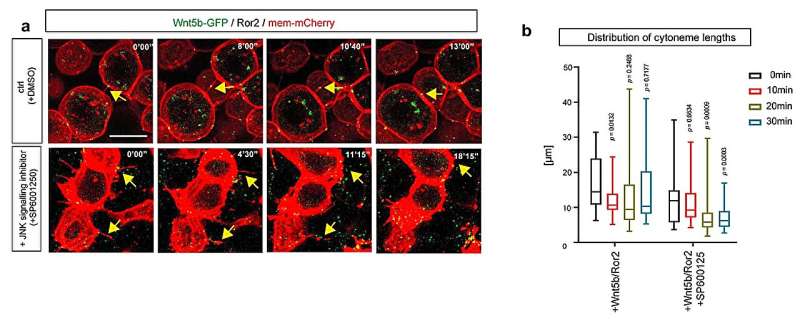December 27, 2023 report
This article has been reviewed according to Science X's editorial process and policies. Editors have highlighted the following attributes while ensuring the content's credibility:
fact-checked
peer-reviewed publication
trusted source
proofread
Novel path of intercellular signal sharing discovered in zebrafish experiments

Researchers at the University of Exeter, U.K., have discovered intricate mechanisms of ligand–receptor complex transport via specialized protrusions transporting signaling components between cells, challenging the conventional understanding of cell responsiveness solely based on receptor expression.
In their paper, "Cytoneme-mediated transport of active Wnt5b–Ror2 complexes in zebrafish," published in Nature, the team investigated the mechanisms behind cell communication in the embryo, specifically focusing on the role of chemical signaling through the Wnt–planar cell polarity pathway in zebrafish.
A Research Briefing published in the same journal issue summarizes the word done by Chengting Zhang and colleagues.
Cellular communication in embryonic development primarily occurs through chemical signaling, where ligands released by signal-producing cells interact with receptors on target cells. In the zebrafish embryo, Wnt5b binds to the receptor Ror2 to trigger the Wnt–planar cell polarity (PCP) signaling pathway to regulate tissue polarity and cell migration.
Through fluorescent tagging, the researchers found evidence indicating that Wnt5b and Ror2 form active complexes in producing cells and are transferred via cytonemes to neighboring cells. Cytonemes are tubular or tubulovesicular cellular filopodia structures involved in several cellular functions. They act as a sort of probe or transport corridor, extending beyond the cell edge to interact with other cells.
The cytoneme-transported complexes maintained their functionality, activating Wnt–PCP signaling in receiving cells, even if they lack functional Ror2 receptors. The findings challenge the conventional view of tissue responsiveness based solely on receptor expression, introducing cytoneme-mediated transfer of signaling complexes between cells as a newly discovered method of intercellular communication.
The experiments involved zebrafish lacking Ror1 or Ror2, and double mutants to understand the roles of these receptors. Wnt5b-Ror2 protein signaling in the sender cells influenced cytoneme formation, resulting in fewer but longer tubulovesicular structures.
The study demonstrated that Wnt5b-Ror2 complexes transported via cytonemes maintained their activity in target cells, activating the receiving cell's intercellular signaling activity. The cytoneme-mediated signaling protein dissemination influenced convergence, extension, and gene expression during the zebrafish's early developmental stages.
Finding a novel cell-to-cell communication mechanism in embryogenesis could have substantial clinical relevance in human embryogenesis, prenatal development and disease states, congenital disabilities and intercellular communication in cancer cells.
Further research is required to replicate and verify such an extraordinary discovery. Beyond replication of the results, the study implies other mechanisms outside the frame of the study's experimental focus, such as a molecular signaling method for intaking a cytoneme-delivered protein or the catalyst for generating longer cytonemes. If confirmed, it will also require a tremendous amount of research into the potential implications of this previously unknown cellular signal-sharing capability on past research.
More information: Chengting Zhang et al, Cytoneme-mediated transport of active Wnt5b–Ror2 complexes in zebrafish, Nature (2023). DOI: 10.1038/s41586-023-06850-7
Zebrafish embryo cells need no receptors to receive signals from afar, Nature (2023). DOI: 10.1038/d41586-023-03659-2
Journal information: Nature
© 2023 Science X Network





















